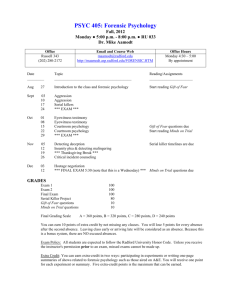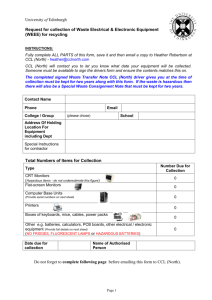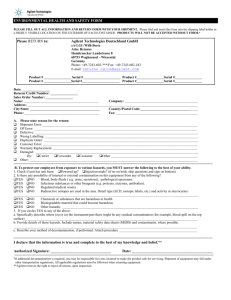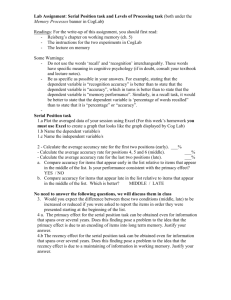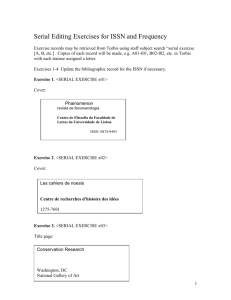CIF_13_UNIT PLAN_Serial Criminals
advertisement
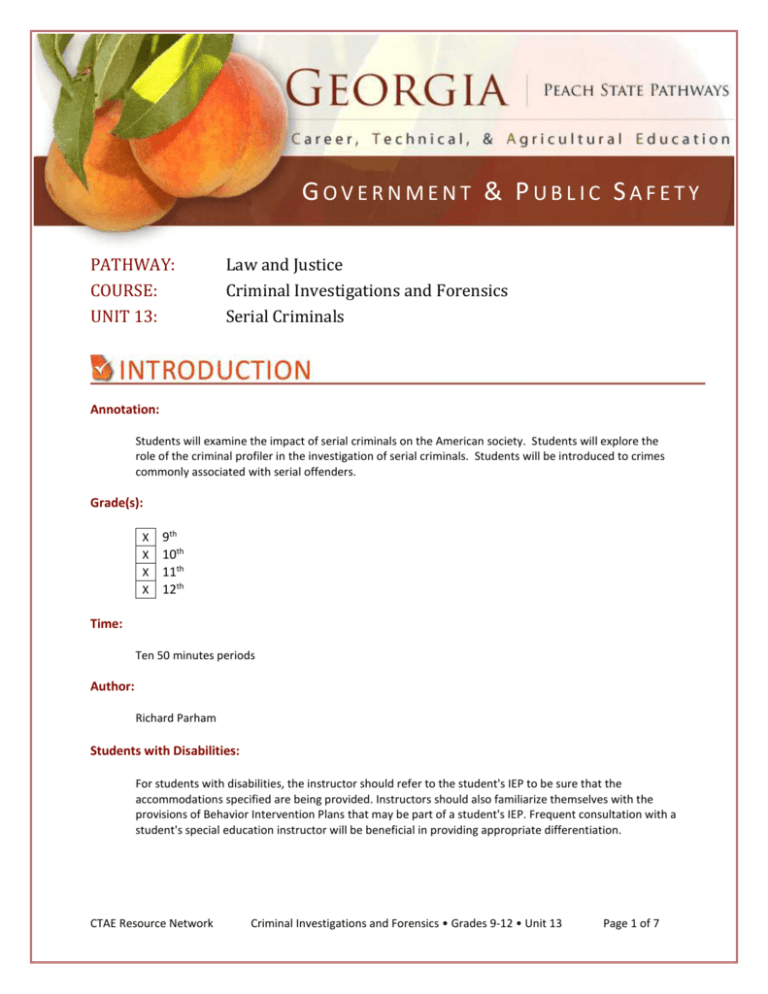
GOVERNMENT & PUBLIC SAFETY PATHWAY: COURSE: UNIT 13: Law and Justice Criminal Investigations and Forensics Serial Criminals Annotation: Students will examine the impact of serial criminals on the American society. Students will explore the role of the criminal profiler in the investigation of serial criminals. Students will be introduced to crimes commonly associated with serial offenders. Grade(s): X X X X 9th 10th 11th 12th Time: Ten 50 minutes periods Author: Richard Parham Students with Disabilities: For students with disabilities, the instructor should refer to the student's IEP to be sure that the accommodations specified are being provided. Instructors should also familiarize themselves with the provisions of Behavior Intervention Plans that may be part of a student's IEP. Frequent consultation with a student's special education instructor will be beneficial in providing appropriate differentiation. CTAE Resource Network Criminal Investigations and Forensics • Grades 9-12 • Unit 13 Page 1 of 7 GPS Focus Standards: PS-CIF-13 Students will demonstrate knowledge of criminal profiling as well as the role of the profiler in an investigation. a) Explain a basic profile of a serial killer. b) Describe the role of a profiler in a serial investigation and as an expert witness during prosecution. c) List classification levels of serial offenders (organized, disorganized). GPS Academic Standards: ELA12LSV1 The student participates in student-to-teacher, student-to-student, and group verbal interactions. ELA10RC2 The student participates in discussions related to curricular learning in all subject areas. ELA10RC3 The student acquires new vocabulary in each content area and uses it correctly. SSCG21 The student will demonstrate knowledge of criminal activity. SSCG22 The student will demonstrate knowledge of the criminal justice process. SB2 Students will analyze how biological traits are passed on to successive generations. Enduring Understandings: How a criminal profile is established. The importance of an accurate criminal profile for identifying a serial offender. How serial killers function “normally” in society. Essential Questions: Can we really create a profile of a serial killer? What makes a serial killer kill? How do I become a criminal profiler? What is a serial offender? Knowledge from this Unit: Students will: Delineate between organized and disorganized serial offenders. Demonstrate knowledge of the basic profile of serial killers. Demonstrate knowledge of the role of a criminal profiler Skills from this Unit: Students will: Identify the most notorious serial killers in United States Identify early behavior traits of past serial killers CTAE Resource Network Criminal Investigations and Forensics • Grades 9-12 • Unit 13 Page 2 of 7 Explain how a person can become an FBI agent Explain the primary motives of serial offenders Assessment Method Type: Pre-test Objective assessment - multiple-choice, true- false, etc. __ Quizzes/Tests __ Unit test X Group project Individual project Self-assessment - May include practice quizzes, games, simulations, checklists, etc. __ Self-check rubrics __ Self-check during writing/planning process __ Journal reflections on concepts, personal experiences and impact on one’s life __ Reflect on evaluations of work from teachers, business partners, and competition judges __ Academic prompts __ Practice quizzes/tests Subjective assessment/Informal observations __ Essay tests __ Observe students working with partners __ Observe students role playing Peer-assessment __ Peer editing & commentary of products/projects/presentations using rubrics __ Peer editing and/or critiquing X Dialogue and Discussion __ Student/teacher conferences X Partner and small group discussions X Whole group discussions __ Interaction with/feedback from community members/speakers and business partners Constructed Responses __ Chart good reading/writing/listening/speaking habits __ Application of skills to real-life situations/scenarios Post-test Assessment Attachments and / or Directions: Unit Terminology Word Wall Profile of a Serial Killer Guided Notes Profile of a Serial Killer Teacher Notes Profile of a Serial Killer PowerPoint Serial Killer Project FBI: Career Project Serial Offender Handout CTAE Resource Network Criminal Investigations and Forensics • Grades 9-12 • Unit 13 Page 3 of 7 • LESSON 1: INTRODUCTION TO SERIAL KILLERS 1. Identify the standards. Standards should be posted in the classroom. PS-CIF-13 Students will demonstrate knowledge of criminal profiling as well as the role of the profiler in an investigation. a) Explain a basic profile of a serial killer. b) Describe the role of a profiler in a serial investigation and as an expert witness during prosecution. c) List classification levels of serial offenders (organized, disorganized). 2. Review Essential Question(s). Post Essential Questions in the classroom. Can we really create a profile of a serial killer? What makes a serial killer kill? How do I become a criminal profiler? What is a serial offender? 3. Identify and review the unit vocabulary. Terms may be posted on word wall. Abduction Behavior Domineering Gratification Introverted Nonsocial Psychotic 4. Adrenaline Cannibalism Eye Witness Humiliation Macdonald Triad Profile Serial Criminals Asocial Criminal Profiling Frustration Inadequate Mutilation Psychological profiling Interest approach – Mental set Show an episode of Criminal Minds to illustrate the basic concept of investigating a serial killer from the FBI’s point of view Have the students make a list of “profiler” terminology that are used throughout the show After the show, find a location in your room for a word wall. Have the students use a marker to write one of their words on the word wall. o Have the student tell the class what they “think” the word means o Take turns going around the room until each student has written a word on the wall, and all the words the students wrote down are included on the word wall. 5. Distribute the Profile of a Serial Killer Notes and lecture using the Profile of a Serial Killer PowerPoint. Use the Serial Killer: a Basic Profile PowerPoint and instruct your students complete the notes as you discuss the PowerPoint. 6. Reserve your school’s computer lab or other location where your class can have access to the internet. Each student is to find information about a serial killer that was in the United States, and create a project that will be presented to the entire class. Your presentation can be a PowerPoint slideshow, a poster or a booklet. **See my notes at the end for some lessons I’ve learned. CTAE Resource Network Criminal Investigations and Forensics • Grades 9-12 • Unit 13 Page 4 of 7 • LESSON 2: A CAREER AS A CRIMINAL PROFILER 1. Review Essential Questions. Post Essential Questions in the classroom. 2. How do I become a criminal profiler? Career Project. You will want to explain to your students that the FBI does not specific job titled; “Criminal Profiler”. This is misconception created by all the television shows related to the topic; however, there are special agents working in the FBI that construct profiles of unknown offenders in addition to providing assistance to other law enforcement agencies. Have the students do a project on the career of an FBI agent as a way to let them understand the educational and work experience that will be necessary to be considered for employment with the FBI. • LESSON 3: THE SERIAL OFFENDER AND THEIR CRIMES 1. Review Essential Questions. Post Essential Questions in the classroom. What is a serial offender? 2. Since you have already covered information on serial killers, you can ask you students to make a list of other crimes that they think would be common for a “serial offender” to commit. Examples will include: serial rapists, serial arsonist, serial armed robbers (think about how bank robbers often follow the same M.O.) 3. Write the list of crimes on the board, or put them on a word wall. Then have the students take each crime (or depending on how many crimes you have, you can have them select 3 or 4 or 5) and write down specific criteria that would make that crime a possible serial offense. • ATTACHMENTS FOR LESSON PLANS CIF-13_Serial Offender Terminology CIF-13_Word Wall CIF-13_Profile of a Serial Killer PowerPoint CIF-13_Profile of a Serial Killer Teacher Notes CIF-13_Profile of a Serial Killer Student Guided Notes CIF-13_Serial Killer Assignment CIF-13_FBI Agent Project CIF-13_Common Crimes of Serial Offender Handout • NOTES & REFLECTION: You may or may not have a text book with information on criminal profilers and serial killers/offenders. There are a lot of resources on the internet that you can access for additional information and ideas. You will want to do some research on the serial killers, and create your own PowerPoint slide show about the killers to facilitate some discussion about serial killers in general. Over the years I have been teaching, whenever I do a unit on serial killers, I always have a number of students who are extremely interested in the topics. You can also have your students work in small groups on a serial killer project. I like to have students work independently; primarily because this makes everyone responsible for the work. CTAE Resource Network Criminal Investigations and Forensics • Grades 9-12 • Unit 13 Page 5 of 7 **Whenever I have students do presentations in class, I have a couple of things that make it smoother. #1-Don’t try to do all the presentations in one or two days. The students will not stay focused that long, and you will begin having minor issues in your “audience” after four or five presentations. To alleviate this, I will determine how many days I will need and then set up a schedule for those days (including the exact time I want each presentation to start. #2-I put all the student names in a bag (or whatever is handy) and have a student draw names; thus establishing the order of presentations in a random manner. #3-I save all the presentations that will be given using a projector on a thumb drive. Then on the day(s) of presentations, all the student has to do is open up their presentation. This saves a lot of time compared to each student using their own individual thumb drive. (Plus it reduces the chances of getting a virus from their personal computers at home. #4-I have the class complete a “student evaluation” of the presentations as they are given. This ensures that everyone will pay attention, plus lets them be a part of the grading system. Culminating Unit Performance Task Title: Serial Killers in America: Where did they attack? Culminating Unit Performance Task Description/Directions/Differentiated Instruction: Put a map of the United States on the wall. Have each student find the basic information about a serial killer. (It can be the one from their presentation, or they may choose another one.) They are to print a picture of the serial killer and write basic facts about the killer (Name, location of the crimes, how many people they killed, etc) on an index card. Tape the picture on the wall next to the map, with the index card below the picture. Use string or yarn to go from the picture to the location on the map where the crimes occurred. Web Resources: http://www.mtholyoke.edu/~mlyount/MySites/ForensicPsychology/CriminalProfiling.html http://www.all-about-forensic-psychology.com/criminal-profiling.html http://www.fbi.gov/publications/serial_murder.htm#two http://people.howstuffworks.com/serial-killer2.htm http://people.howstuffworks.com/serial-killer.htm http://www.trutv.com/library/crime/serial_killers/notorious/tick/victims_1.html Materials & Equipment: Computers or lab Projector/TV CTAE Resource Network Criminal Investigations and Forensics • Grades 9-12 • Unit 13 Page 6 of 7 Episode of Criminal Minds Poster Board, Easel Pad, Easel size Post-it 21st Century Technology Used: X Slide Show Software Interactive Whiteboard Student Response System Web Design Software Animation Software Email CTAE Resource Network X X Graphing Software Calculator Desktop Publishing Blog Wiki Website Audio File(s) Graphic Organizer Image File(s) Video Electronic Game or Puzzle Maker Criminal Investigations and Forensics • Grades 9-12 • Unit 13 Page 7 of 7




